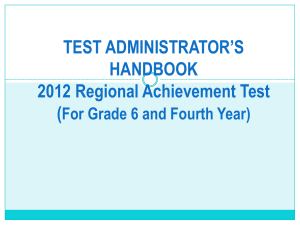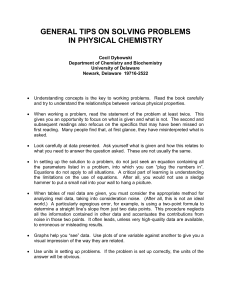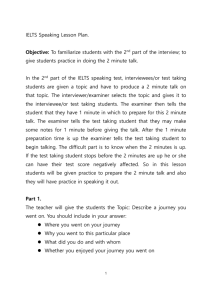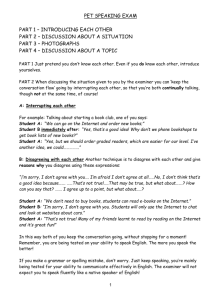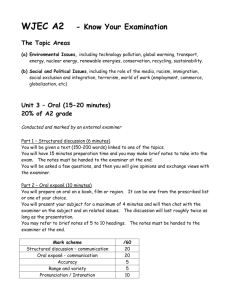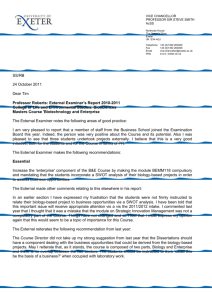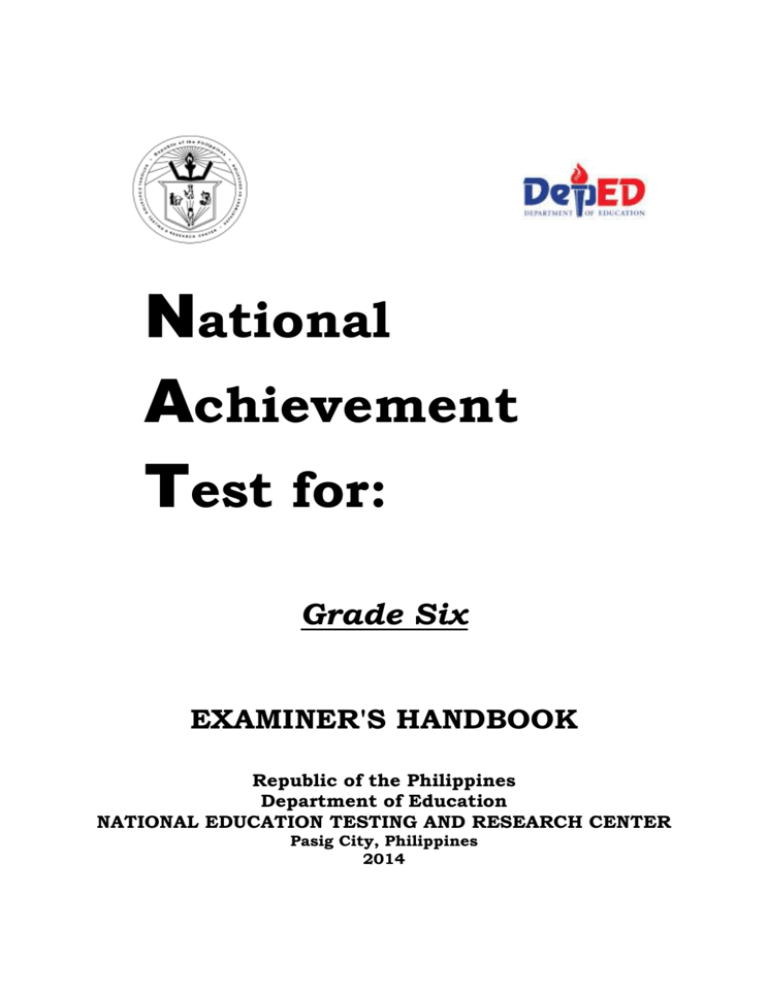
National
Achievement
Test for:
Grade Six
EXAMINER'S HANDBOOK
Republic of the Philippines
Department of Education
NATIONAL EDUCATION TESTING AND RESEARCH CENTER
Pasig City, Philippines
2014
3
EXAMINER’S HANDBOOK
NATIONAL ACHIEVEMENT TEST
1. INTRODUCTION
This Examiner’s Handbook is intended for those involved in the administration
of the National Achievement Test for Grade Six pupils. It outlines the activities to be
undertaken at various stages in the activity. To ensure a standardized test
administration, this Handbook must be followed strictly.
The Chief Examiner’s (CE) Workflow
A. Pre-Test
Activities:
Keeps the
confidentiality
of the test
materials
Requires
every Room
Examiner to
count the
TB’s while
plastic bags
are still
sealed
Facilitates the
signing of
Form 3 by RE
B. Test
Proper:
Accomplishes
Forms 4, 5
and 6
Monitors the
testing staff
activities
C. Post-Test Activities:
Accounting of Materials
1. Collects and accounts all ETRE’s
assisted by the School Testing
Coordinator/Room Supervisor
2. Arranges
and
bundles
them
accordingly seeing to it that the number
of ETRE’s tallies with the number of
testing rooms. A report on the number
of ETRE’s should accompany the
bundle.
3. Returns to their original plastic bags
all used and unused Test Booklets with
serial numbers arranged consecutively.
These should be resealed by stapling
the open end of the plastic bag.
4. Places inside the CETRE the
following materials after accomplishing
the Chief Examiner’s Transmittal
Report: (Unused Answer Sheets,
NETRC Form 3, NETRC Form 4 and
the School Header)
5. Accomplishes the NETRC Forms 5, 6
all to be submitted to the DTC following
the instructions
6. Submits to DTC Forms 5 and 6
separately
4
The Room Examiner’s (RE) Workflow
Examination Room
Distribution Room
(Retrieval Phase)
Posts the replica of the Name Grid and the test
coverage
Gives the General Directions
Distributes the AS then the TB’s
Checks if Name Grid, LRN and other information in the
AS are properly shaded
Facilitates in accomplishing the Form 2 by examinees
Administers the Test using Examiner’s Handbook
Keeps custody of the excess TB’s in original plastic
bags while the test is in progress and the test items
are not read by the RE (with sanctions re DepED Order
No. 85, s. 1999)
Accomplishes Form 1 and Form 7
Retrieves the TB’s
Checks the contents of the ETRE
(Used AS arranged consecutively by
Examinee Number, Time
Record, Forms 1, 2 and 7
Seals the ETRE while still in the Examination Room
Submits the
Examiner’s
Handbook, sealed
ETRE and the
consecutively
arranged TB’s to be
properly accounted
for by the Chief
Examiner
Retains the Replica
of the Name Grid and
Examinee Stubs of
the examinees in the
Guidance Office
Distribution Room
Receives the TB’s &
AS’s
Counts the TB’s
from the sealed
plastic bags
Signs the Form 3
2.1 PRE-TEST
2.1.1 Board Work
Write the parts of the test on the board or on a Manila paper including the time the
test has started and the time it will be finished, as shown below.
One Test Booklet (TB) for Mathematics, English, Science, Filipino, and HeKaSi
Parts of the Test
General Directions & Sample Items
Part I (EDQ)
Part II (Test Proper)
Filipino
Mathematics
English
Break
Science
HeKaSi
Total Time Limit
Item
Numbers
Time Limit
5 mins
5 mins
1- 15
1 – 40
1 – 40
1 – 40
Time
Started
______
______
Time
to End
______
______
______
______
15 mins
1 – 40
1 – 40
______
______
3 hours 50 mins
Use the same board work for the afternoon session
5
2.1.2 Entrance and Seating Arrangement
1. Inspect the seating arrangement before instructing the examinees to enter the
testing room. There should be six rows of armchairs or three rows of desks. In
the rows of desks, the first desk from the right (when Room Examiner faces the
class) are Rows 1 and 2, the second desk are Rows 3 and 4, and the third desk
are Rows 5 and 6. Two pupils shall be seated in each desk.
2. Instruct the examinees to line up outside the room in alphabetical order of their
surnames.
3. Instruct them to enter the room also in alphabetical order of their surnames. Let
the first six examinees occupy the front line first, then the second, until the last
line as shown below:
Chalkboard
Examiner’s Table
Line 1
Line 2
Line 3
Line 4
Line 5
Row 1
1
7
13
19
25
Row 2
2
8
14
20
26
Row 3
3
9
15
21
27
Row 4
4
10
16
22
28
Row 5
5
11
17
23
29
Row 6
6
12
18
24
30
4. In no case shall there be more than 30 examinees in a room.
5. Check the attendance by calling out the names of the examinees from the list in
NETRC Form 1, List of Examinees, prepared by the School Principal/Testing
Coordinator.
6. Check the identities of the examinees inside each examination room by all
means (e.g. ID, notebooks bearing the examinee’s name; etc.) using the
following procedure:
a. Countercheck the identity through the ID.
b. If ID is not available, ask the examinee to present a notebook or any
belonging bearing his/her name.
c. In the absence of requirements for a & b identification materials, ask
his/her respective classmates inside the Examination Room to attest the
identity.
7. Instruct them that all belongings are placed in front of the room underneath the
blackboard; except the pencils, sharpener and a clean sheet of paper.
2.1.3 Orientation of the Examinees
After the examinees are seated and all chairs are cleared, say:
Good morning everybody. I am (State your name). These are some points you
should remember to follow while taking the test. I shall read each one.
Read the following slowly and clearly:
1.
2.
3.
4.
You will answer all five subjects.
If possible, you are not allowed to leave the room once the test has started.
Do not open your Test Booklet until you are told to do so.
If you have any problem such as missing pages or words that are not printed clearly,
raise your hand so I can help you.
6
5. Questions on the directions or on any test item will not be entertained after the test
has started.
6. Do not write anything on the Test Booklet. A separate Answer Sheet is provided for
your answers. For those answering Mathematics, you may use a clean sheet of
paper for your computation but submit this to me after the test.
7. Use lead pencil No. 2 in answering the test. Mechanical pencils are not allowed
8. Remember to keep your Answer Sheet clean and free from unnecessary marks. DO
NOT fold, crumple, or crease any portion of it, otherwise it may be rejected by the
scanning machine.
9. Select your answer from the given choices, and blacken the circle that corresponds
to your answer in the appropriate item number on your Answer Sheet.
10. You may change your answer by erasing it neatly.
11. Work quietly and mind only your own work. Do not use books, dictionaries, rulers,
calculators, and cell phones inside the testing room.
12. Refrain from cheating. If you are caught cheating and have been warned twice, but
persist on cheating, you will not be allowed to take the test any further.
13. The total time for the test will be 3 hours and 50 minutes.
14. Work fast enough so you will finish the test within a given time. If you finish the test
ahead of time review your answers.
15. I will announce when the given time to finish the test is up.
16. When I say STOP, put your pencils down.
After you have read the guidelines, allow examinees to go out, if necessary, before
distributing the materials.
2.1.4. Distributing the Answer Sheet (AS) and Test Booklets (TBs)
Cut with a pair of scissors or a blade one end of the plastic bags (one containing
the TBs and the other the AS). Check their quantities and see to it that these are
accurate and not tampered. In a pack there are thirty (30) TBs. Each examinee will
have one TB and one AS.
In the distribution of the TBs and AS follow the numbering of examinees shown
on Page 5. Start with the examinee in Number 1, by giving him/her the TB/AS with the
lowest serial number and end with examinee in Number 30, giving him/her the highest
serial number.
Seats of late comers / absentees should be left vacant. Test Booklets and Answer
Sheets allocated to the said examinees should be placed inside the original
plastic bag by the Room Examiner pending their arrival. However, the Test
Materials should not be distributed yet if there are only less than 10 examinees in
the room.
2.1.5 Checking the Test Booklets and Answer Sheets
After each Examinee has received a Test Booklet and an Answer Sheet, say:
Everybody, put the Answer Sheet on your chair/desk. (Wait until everybody has
done this.) Look at your Test Booklets. (Pause.) Check the pages one by one. If you
notice any misprint or a missing page, raise your hand and I will change it.
Pause. Wait until everybody has done this. Then say:
Everybody, look at your Answer Sheet. Find out if there are defects. In case
there are, raise your hand and I will change them.
7
Pause. Look for raised hands. In case a Test Booklet or an Answer Sheet is
defective, the whole set must be changed. Get this from the regular pack, if there are
extras; if none, request the Room Supervisor to give you the exact number of copies
needed from the buffer which is in the custody of the Chief Examiner. This should be
noted in the Examiner’s Report. When all Test Booklets and Answer Sheets have been
checked, keep the unused TB and AS in your custody. These will be packed with the
others upon submission of reports to the Chief Examiner/School Testing Coordinator
during the post test.
Let us begin this examination with a prayer printed on page 1 of your Test
Booklet. All together, read it silently. Begin.
2.1.6 Filling in of Information in the Answer Sheet
The Answer Sheet is composed of two (2) pages printed back to back broken
down as follows: The front page (Page 1) contains the circles for the basic information
about yourself. The back page, (Page 2) contains the Examinee’s Descriptive
Questionnaire (EDQ) circles numbered 1 – 15. It also contains circles numbered 1 – 40
for Filipino, 1 – 40 for Mathematics, 1 – 40 for English, 1 – 40 for Science, and 1 – 40
for HeKaSi. In marking the circle, see to it that the whole space within the circle is fully
shaded.
2.1.6.1 Filling up the Name
Say:
You shall now fill in the information called for on the front page of the Answer
Sheet (Replica on page 1). First of all, print your name inside the box provided for in the
examinee stub found on the upper portion of the AS. Then print your name inside each
box provided for in the name grid.
Pause. Give the Examinees enough time to write their names. Then say:
Let us accomplish the name grid found on the upper portion of the Answer Sheet.
The basic rules in filling up the name grid are as follows:
1. Write only one letter in each box starting with the first box at the left. Below letter Z
are Ñ and dash (-).
2. Enter your last name first, then your first name(s) in the allotted box and finally your
middle initial in the last box. If you are a “JR", "III", "IV", etc., write it immediately
after your last name but leave one blank box in between.
3. If your last name consists of two or more words such as dela Cruz, delos Santos, San
Ignacio, etc., write your last names leaving a blank box between. Likewise, if you
have two first names write them leaving a blank box in between.
4. If you have long last names and/or first names fill your names up to the last box
allotted for your last names and first names.
5. There are two columns for the middle initial. If you have two or more middle names
write only the first letter of the first and second middle names (e.g. SJ for San Juan).
If you have one middle name, write the first letter in the first box at the left.
Pause. Let the Examinees follow the instruction, then, say:
If you have filled in your surname, first name and middle initial, blacken the circle
below each box which corresponds to the letters written in the boxes.
8
Go around to see that this is done by the Examinees correctly.
2.1.6.2 Filling Up Learner Reference Number (LRN)
Say:
Blacken the circle corresponding to your 12-digit LRN. It consists of twelve
numbers. Check your LRN given by your class adviser. (Go around to check that
numbers for the LRN are written correctly in the corresponding boxes).
2.1.6.3
Filling up Birth Date
Say:
The Birth Date is given in the form of month-day-year, specifically:
Example: January 6, 1996
Month - Blacken the circle corresponding to the month of birth which is January.
Day - Two columns are allotted for the day although one circle in
each column is blackened. The range is from 01 to 31. Days
ranging from 1 to 9 are entered as 01 to 09, so blacken 0 in the
first column and 6 in the second column.
Year - Only the last two digits of the year of birth are entered.
Blacken 9 in the first column and 6 in the second column.
2.1.6.4 Filling up Nutritional Status
Say:
Blacken the circle corresponding to your nutritional status. Example: If you are
above normal, blacken above normal; if you are normal, blacken normal.
2.1.6.5 Filling up School ID, Region and Division Codes
Say:
Your school code is composed of region, division, and school ID. Region and
division codes are in combined letters and numbers. School ID is in numbers only.
(Refer to your school code in the allocation of your test materials). Write your School
Code, one letter/number to a box. Check your school code against the school code
written on the board. Blacken the circles that are the same as the letters/numbers you
have written in the boxes. (Go around to check if the School Code is written correctly).
2.1.6.6 Filling up Gender
Say:
Indicate your gender by shading the corresponding circle. Example: If you are a
boy, shade male. If you are a girl, shade female.
2.1.6.7 Filling up Number of Pupils/Students in A Class/Section
(How many are you in your class/section?)
Say:
Blacken the circles that correspond to the number of pupils/students in your
regular class/section. Example: If you are sixty-five (65) in your regular class/section,
blacken 6 in the first column and 5 in the second column.
9
2.1.6.8 Filling up School Subject Grade
Say:
Blacken the circles that correspond to your ratings during the third grading period
in the five subject areas: Math, English, Science, Filipino, and HeKaSi. Example: If your
grade in Mathematics is 90 blacken 9 in the first column and 0 in the second column.
2.1.6.9 Filling up Type of Community
Say:
Blacken the circle corresponding to the type of community you are living in. If
you are living in a rural area, blacken rural. If you are living in an urban area, blacken
urban.
2.1.6.10 Filling up Enrolled in MADRASAH
Say:
Indicate whether you are enrolled in MADRASAH or not. Example: If you are
enrolled in MADRASAH, blacken yes, if not, blacken no.
2.1.6.11 Filling up Number of Shifts per Day
Say:
Indicate whether your section holds classes the whole day, being single
shift (Shade 1); if in two shifts shade 2 (holding half day classes); shade 3 if in 3
shifts; and so forth.
2.1.6.12 Filling up Do You Belong to a Section with Special Science
Curriculum
Say:
Indicate whether you belong to a section with Special Science Curriculum.
Example: If you belong to this section, blacken yes, if not, blacken no.
2.1.6.13 Filling up Name and Address of School
Say:
Write also the name and address of your school on the space provided.
2.1.6.14 Writing the Signature
Say:
Sign your name and signature on the space provided.
Give the Examinees enough time to do this. Check that each Examinee does this
correctly.
It is imperative that you check and double check that all Examinees have shaded
the correct circles pertaining to the NAME GRID and all the necessary information about
the Examinee. To do this, go around and inspect each Examinee’s Answer Sheet. (THIS
IS VERY IMPORTANT.)
10
2.2
TEST PROPER
2.2.1 Reading the General Directions (5 minutes)
Everybody, open your Test Booklets. Read the general directions and the
examples silently and with understanding. I will give you 5 minutes to do this.
2.2.2
Administering the Examinee’s Descriptive Questionnaire (EDQ)
After five minutes, say:
Part I, the Examinee’s Descriptive Questionnaire (EDQ) is not a test. It consists
of ten (10) items on some information you are to give answers. After each item on your
Answer Sheet, shade the circle of the letter that corresponds to your answer to that
particular item. Some items require more than one answer. Do not leave any item
unanswered.
Part I will last for 5 minutes. Record your answers for this part on the upper
portion of the back page of the Answer Sheet. Everybody, open your Test Booklets to
the EDQ.
(Show them the EDQ portion), Ready… Begin!
2.2.3 Accomplishing the Seat Plan, NETRC Form 2
While the examinees are answering the EDQ, each examinee will write his/her
Name, Examinee Number, and the Test Booklet Number on the Seat Plan. Fill in the
Region, Division, School Name and Address, Date of Examination and Room Number.
2.2.4 Administering the Subject Area Test in Filipino, Mathematics,
English, Science, and HeKaSi (3 hrs and 50 mins)
After five minutes, say:
Are you now ready to start answering the test? The test proper for this morning
will last for four hours. Ready ... Begin.
Record on the board the time started and the time to end for lunch break. After
the third subject, say:
Place your TB and AS under your seats while you take your snacks.
2.2.5 Continuing the Test After Snacks Break
After snacks break say:
We are about to continue the test. The test will end at (point to the written time to
end on the board).
Go around and see to it that the examinees are recording their answers properly.
Record on the board the time to end. The recorded time to end is from the time it started,
excluding the 15-minute snacks break.
Note: The unused Scannable Answer Sheets shall be collected by the Room
Supervisor/Chief Examiner at the time when the Examinees are answering the last
subtest. Likewise, the filling out of the remaining data in Form 3 should be done
at this time.
11
2.2.6 Collecting the Answer Sheets and the Test Booklets
After the recorded time to end, say:
Everybody, stop writing. Close your test booklets.
You are given 5 minutes to inspect your Answer Sheet. Make sure your
erasures, if any, are clean. See to it that the circle selected for each item is shaded
properly. The circle should have uniform shading. Be sure that only one is shaded for
each item. Tear off carefully (not using a pair of scissors) the examinee stub found on
the upper portion of the front page of your Answer Sheet. These will be kept by your
Guidance Counselor for your certificate of rating.
Go around to make sure the Examinees have shaded the NAME GRID
properly and have torn the examinee stub. After the inspection has been done, say:
I will go around to collect your test booklets, answer sheets, your scratch papers
and the Examinee Stubs.
Collect and count all used and unused test booklets and answer sheets and
place these in the original plastic bags. Make sure that all materials have been retrieved.
In case a Test Booklet is missing exhaust all means to find it. DISMISS EXAMINEES
ONLY AFTER ACCOUNTING THESE TEST MATERIALS.
2.2.7 Dismissing the Examinees
After all materials are accounted for, say:
We are through with the test. You may now go out quietly in single file.
2.3 POST TEST
2.3.1 Preparing the Reports and Sealing the ETRE
2.3.1.1 Do the following activities:
1. Accomplish Form 7, the Room Examiner’s Test Administration – Evaluation
Report.
2. Copy from the board the Time Record Report on Test Administration.
3. Indicate in the ETRE the number of registrants and the number of actual
examinees.
2.3.1.2
Place the following inside the Room Examiner’s Transmittal
Report Envelope (ETRE):
1. Time Record Report
2. Used Answer Sheets arranged consecutively by Examinee Number
Placed in original plastic bag
3. One Copy of NETRC Forms 1 and 2 (back to back) and Form 7
2.3.1.3
Seal the ETRE with the DepED-NETRC paper tape while still inside the
examination room.
2.3.2 Turning Over of Materials to the Chief Examiner
Turn over to the Chief Examiner the following materials:
2.3.2.1
2.3.2.2
Sealed ETRE with its contents
Used and unused Test Booklets assembled together and arranged
consecutively by Serial Numbers packed in their original plastic bags,
12
2.3.2.3
retaining the Batch Slip inside the plastic bag.
Examiner's Handbook
2.3.3 Accounting of Materials by the Chief Examiner
The Chief Examiner does the following:
2.3.3.1
Collects and accounts all ETREs, arranges and bundles them accordingly
seeing to it that the number of ETREs tallies with the number of testing
rooms. A report on the number of ETREs should accompany the bundle.
2.3.3.2
Counts the Test Booklets per pack retrieved from each Examiner with the
assistance of the Room Supervisor. The open end of the plastic bag must be
resealed by tape or stapler.
2.3.3.3
Places inside the CETRE the following materials after accomplishing
the Chief Examiner's Transmittal Report:
1.
2.
3.
4.
2.3.3.4
Unused Answer Sheets with serial numbers arranged consecutively.
NETRC Form 3 Test Materials Accounting Form
NETRC Form 4 Chief Examiner's Report Form
School Header
Instructions to the Chief Examiner and the DTC relative to Forms 5 and 6:
1. Separate the two Forms by cutting the perforated lines.
2. Fill out the needed data in both forms.
3. These forms should be submitted to the Division Testing Coordinator
(DTC) and not placed inside the CETRE.
4. The DTC puts all Form 5’s submitted to him/her by every Chief Examiner
in the First Box of the Division’s boxes for the Test Booklets.
5. Do the same with Form 6 but all of Form 6’s will be placed in the First Box
of the Division’s boxes for the Answer Sheets.
2.3.4 Packing of Test Materials
The following materials are for submission to the Division Office:
1. Bundles of R/CETRES placed in the original boxes
2. Bundles of used and unused Test Booklets sealed in plastic bags and
placed in the original boxes
3. NETRC Form 5, Test Booklet Quantity and Completeness Verification
Sheet, to be inserted in box no. 1 on top of the test booklets
4. NETRC Form 6, Answer Sheet Quantity and Completeness Verification
Sheet to be inserted on top of the first box of the Answer Sheets.
5. Examiner’s Handbook, counted and ready for future use, to be retained in
the office of the Division Testing Coordinator
6. The enlarged replicas of the name grid shall be retained in the
schools/Testing Centers for future use.
TO THE DIVISION EXAMINATION COMMITTEE:
This Examiner’s Handbook should be stored in the Testing Center/School
after the test together with the Name Grid Replica for future use.
Thank you very much for your cooperation.
13
NETRC
ALL RIGHTS RESERVED
No parts of this handbook may
be reproduced in any form.
Prepared by:
Test Development Division

